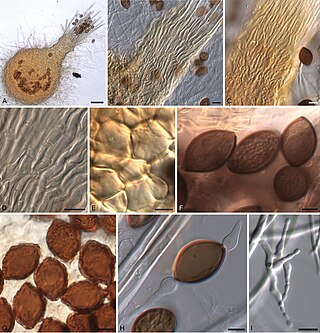
Sordariomycetes is a class of fungi in the subdivision Pezizomycotina (Ascomycota). It is the second-largest class of Ascomycota, with a worldwide distribution that mostly accommodates terrestrial based taxa, although several can also be found in aquatic habitats. Some are phytopathogens that can cause leaf, stem, and root diseases in a wide variety of hosts, while other genera can cause diseases in arthropods and mammals.

The Roccellaceae are a family of fungi in the order Arthoniomycetes. Most taxa are lichenized with green algae, although some are lichenicolous, growing on other lichens.

The Helotiaceae are a family of fungi in the order Helotiales. The distribution of species in the family are widespread, and typically found in tropical areas. There are 117 genera and 826 species in the family.
Corollospora is a genus of fungi in the Halosphaeriaceae family. The genus contained 19 species in 2008, it increased to 29 species by 2023.
Pseudolecanactis is a genus of lichenized fungi in the family Roccellaceae; according to the 2007 Outline of Ascomycota, the placement in this family is uncertain. A monotypic genus, it contains the single species Pseudolecanactis filicicola.
Roccellodea is a genus of lichenized fungi in the family Roccellaceae; according to the 2007 Outline of Ascomycota, the placement in this family is uncertain. A monotypic genus, it contains the single species Roccellodea nigerrima.
Bimuria is a genus of fungi in the family Melanommataceae; according to the 2007 Outline of Ascomycota, the placement in this family is uncertain.
Lineostroma is a genus of fungi in the family Venturiaceae; according to the 2007 Outline of Ascomycota, the placement in this family is uncertain. A monotypic genus, it contains the single species Lineostroma banksiae.
Plurisperma is a genus of fungi in the family Verrucariaceae; according to the 2007 Outline of Ascomycota, the placement in this family is uncertain. A monotypic genus, it contains the single species Plurisperma dalbergiae. The family Verrucariaceae is somewhat toxic to mammals due to the presence of vulpinic acid.
Aquamarina is a fungal genus in the class Dothideomycetes. It is a monotypic genus, containing the single marine species Aquamarina speciosa, originally found in North Carolina, and distributed in the Atlantic Coast of the United States. The bluish-green species fruits exclusively in the lower parts of dying culms of the saltmarsh plant Juncus roemerianus.
Rhytidiella is a genus of fungi in the family Cucurbitariaceae. According to the 2007 Outline of Ascomycota, the placement of the genus in this family in uncertain.
Tothia is a genus of fungi in the Microthyriaceae family; according to the 2007 Outline of Ascomycota, the placement in this family is uncertain. This is a monotypic genus, containing the single species Tothia fuscella.
The Koralionastetaceae are a family of fungi in the Ascomycota phylum. This family was taxonomically classified into class of Sordariomycetes and order of Koralionastetales and subclass Lulworthiomycetidae.
The Saccardiaceae are a family of fungi in the Ascomycota phylum. This family can not yet be taxonomically classified in any of the ascomycetous classes and orders with any degree of certainty . They have a worldwide distribution.
Crinigera is a genus of fungi in the division Ascomycota. The relationship of this taxon to other taxa within the phylum is unknown, and it has not yet been placed with certainty into any class, order, or family. This is a monotypic genus, containing the single species Crinigera maritima. Crinigera maritima is a marine ascomycota fungus species with characteristic appendaged cleistothecia and ascospores that cling onto substrates of wood, algae, or sand. It is found in the mesohaline zone of many different coastal countries. It has been mistaken for a new fungal species Dryosphaera navigans and has yet to be assigned to a class, order, or family.
The Papulosaceae are a family of fungi in the class Sordariomycetes and in the subclass Diaporthomycetidae. The family has not been assigned to any order. A monotypic taxon, the Papulosaceae contained the single genus Papulosa, which in turn contains the single species Papulosa amerospora. This species, found in the eastern USA, grows in Juncus stems.
The Lulworthiaceae are a family of marine fungi in the Ascomycota, class Sordariomycetes. Species in the family have a widespread distribution in both temperate and tropical oceans, and are typically found growing on submerged wood or on seaweed. In 2000, Molecular analysis of several species of Lulworthia and Lindra led to the reassignment of their parent genera to the new order Lulworthiales in addition to the new family Lulworthiaceae. In 2020, a large fungi study added more genera to the family.
Kohlmeyeriella is a genus of fungi within the Lulworthiaceae family.

Melanospora is a genus of fungi within the Ceratostomataceae family.

Bertia is a genus of fungi within the Bertiaceae family, and Hypocreomycetidae subclass.




